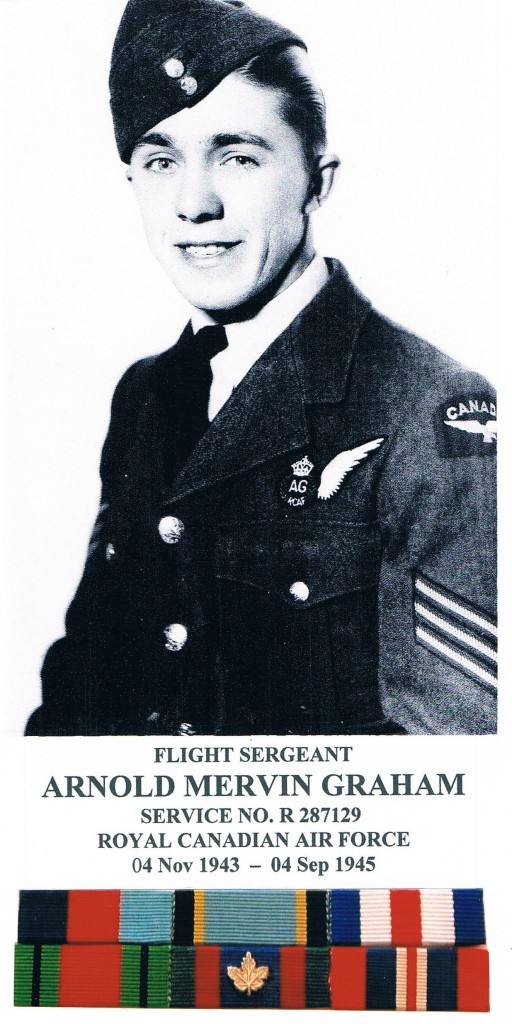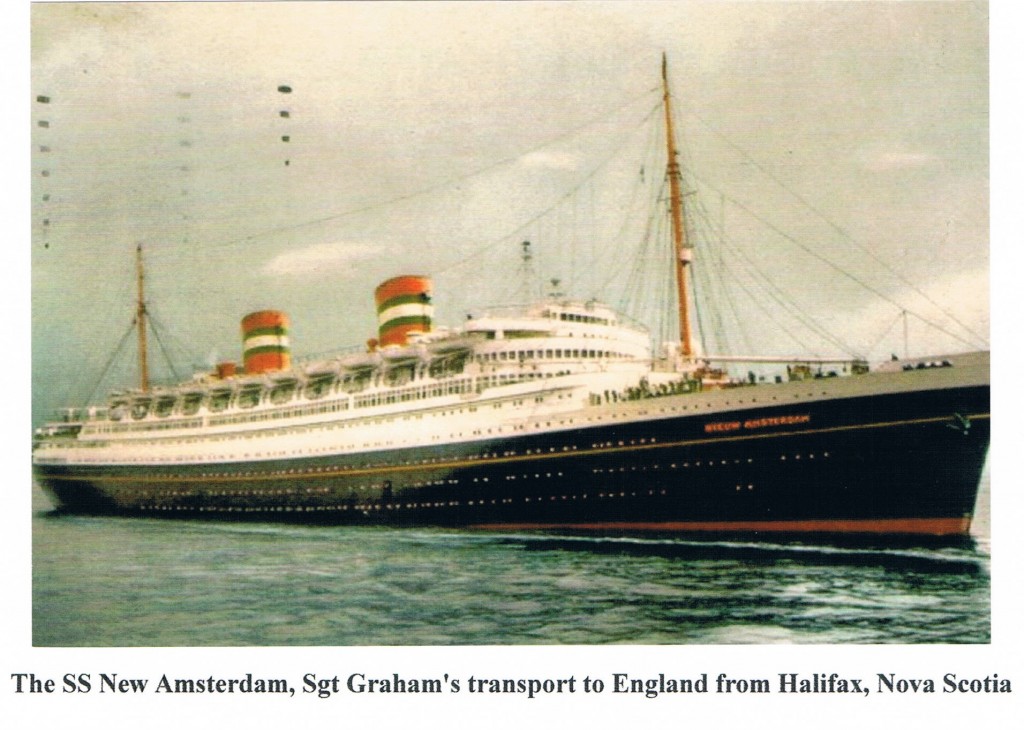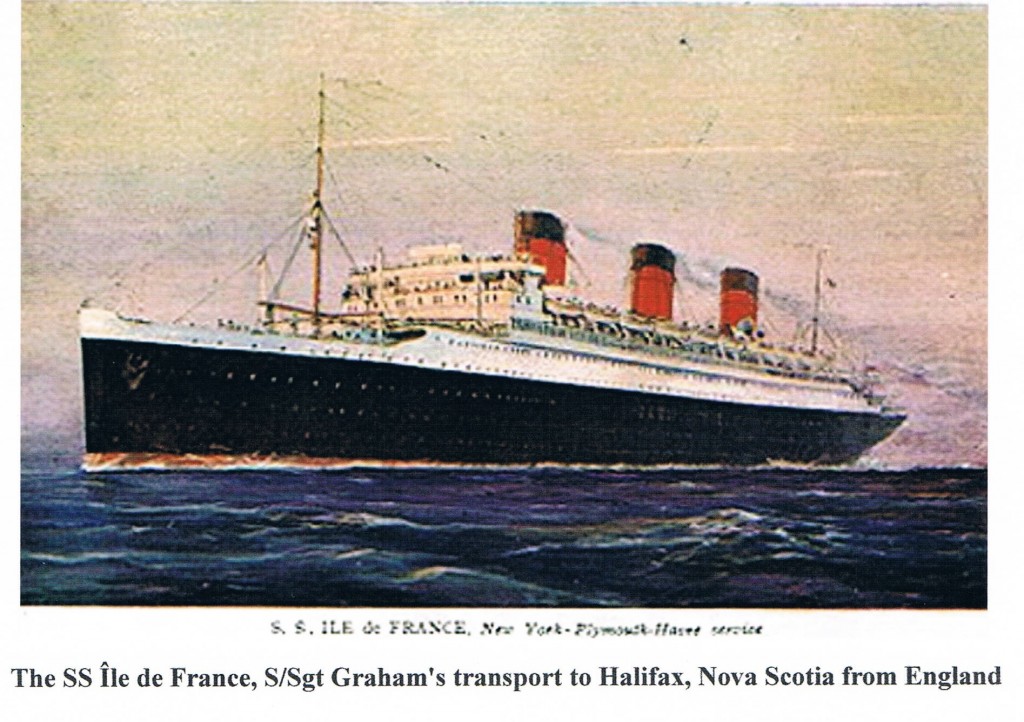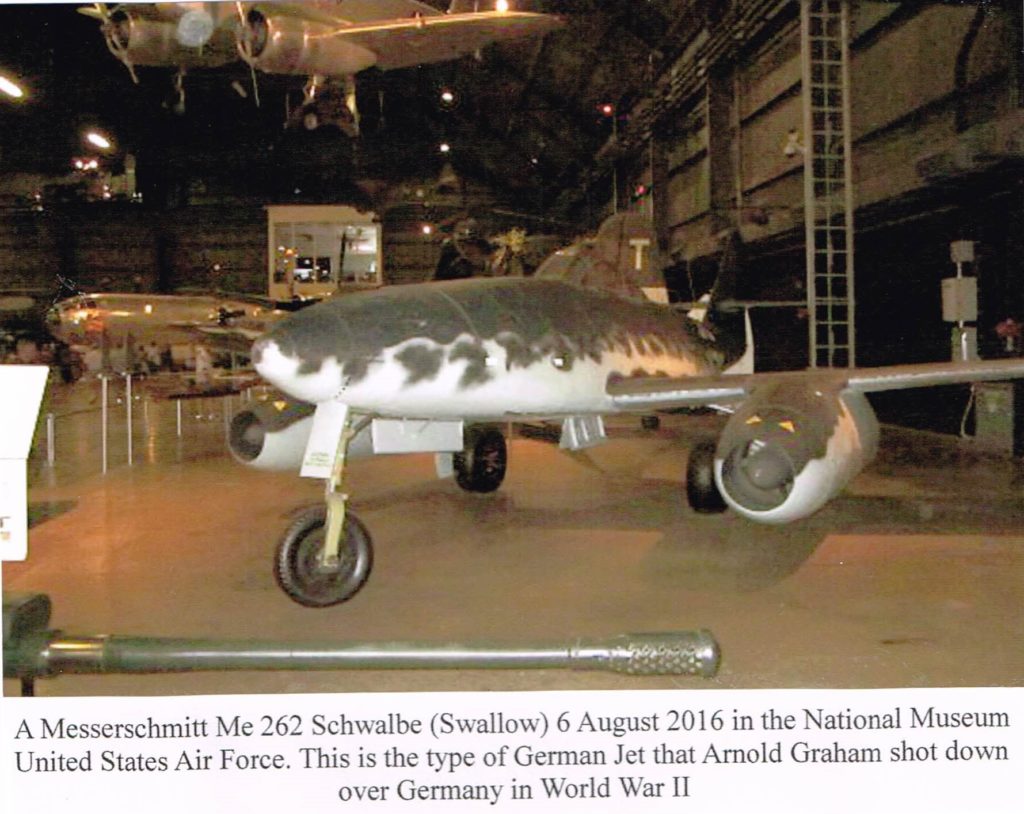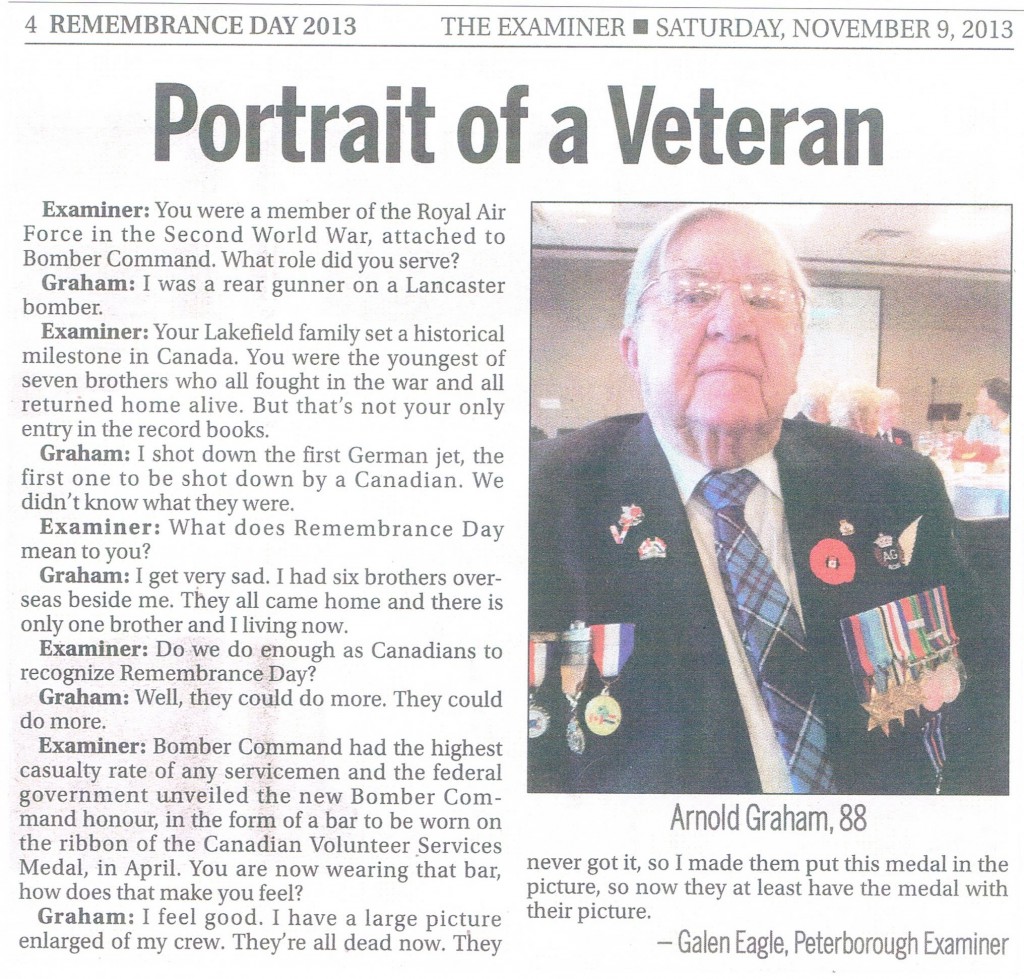MILITARY HISTORY
Private Arnold Mervin Graham – C 463018 — RESERVE SERVICE (Pre-World War II)
Arnold was ten days shy of being 17 year old when, as a single man, he enlisted, in Lakefield Ontario, on December 2, 1942 with the 2nd (Reserve) Battalion, Prince of Wales Rangers (Peterborough Regiment). He gave his birth-date as December 12, 1925 and indicated that he had no previous military experience. His previous employment was listed as an employee of the Peterborough Canoe Company. At the time Arnold was 5′ 6″ tall, 34½” chest and weighed 124 pounds. Arnold’s next-of-kin was his mother, Clara Graham [his father passed away February 18, 1931]. He entered as a Private (Pte) with service number C 463018 and was posted to D Company. Pte Graham was released from the Reserve Service May 8, 1943 in order to enlist with the Royal Canadian Air Force.
Flight Sergeant Arnold Mervin Graham – R 287129 — ACTIVE SERVICE (World War II)
Arnold was 17 years, 10 months old when, as a single man, he had his medical done and enlisted at the Royal Canadian Air Force (RCAF) No. 11 Recruiting Centre (RC), Toronto Ontario on November 4, 1943. Arnold had signed an Enlistment Agreement indicating that he would accept to be allocated to any aircrew category and may be called upon to perform duties not directly or indirectly connected with an aircrew trade until an aircrew trade position is available. He gave his birth-date as December 12, 1925 and did not indicate that he had previous Military Reserve experience. Since Arnold was over 17½ but not yet 18 years old his mother was required to provide a letter authorizing his entrance into the RCAF which she provided. He had completed Grade 10 in High School at Lakefield, Ontario. His previous employment was listed as a burner in shipyards. At the time Arnold was 5′ 4½” tall, 35½” chest, weighed 127 pounds, blue eyes, dark brown hair and had a tattoo on his right forearm stating “MOTHER”. Arnold’s next-of-kin was his mother, Clara Graham. Included in the references on his Attestation Paper; from Lakefield were High School Principal J. F. Harvey, Dentist Dr. J. Renwick and barber D. Millar. Arnold was assigned Service Number R 287129 with the rank of Aircraftsman 2nd Class (AC 2) [Private Recruit equivalent] and his trade was Standard Aircrew. He was assessed as a husky lad, good Air Gunner material. He also had stated that he had been in the Boy Scouts and was semi-skilled in carpentry work.
November 4, 1943 AC 2 Graham was transferred from RCAF, 11 RC and taken on strength to No 5 Manning Depot (5 MD) in Lachine Québec. His basic training at 5 MD would include taking orders, drill exercises for physical fitness, studies and endless series of inoculations. AC 2 Graham did not follow the standard training plan as given in the British Commonwealth Air Training Plan (BCATP). He didn’t go through the Initial Training School (ITS) since a lot of aircrews were being lost and there was a dire need for some new recruits to bypass pilot training and proceed directly to other aircrew positions. Since the availability of Air Gunners was low AC 2 Graham was channeled into that trade.
On December 5, 1943 AC 2 Graham was struck off strength from 5 MD, Lachine Québec and was taken on strength to No 1 Manning Depot (1 MD), Toronto Ontario on December 6, 1943. On December 10, 1943 AC 2 Graham proceeded to the Central Technical School were advanced subjects were taught. On January 23, 1944 after 44 days at this school he was struck off strength from 1 MD, Toronto Ontario. He was then taken on strength to the Service Flying Training School (SFTS) at St. Hubert Québec on January 24, 1944. The SFTS provided him18 days of familiarity with aircraft that were being flown in combat operations. On February 11, 1944 AC 2 Graham departed from the SFTS, St. Hubert Québec and moved to the Bombing & Gunnery School (B & GS) at Mont Joli, Québec the same day.
During the next 41-day period AC 2 Graham enjoyed rank and trade promotions. He was promoted to Leading Aircraftman (LAC) [Private Trained equivalent] March 25, 1944 and qualified as an Air Gunner (AG). Then on May 5, 1944 he was promoted to Sergeant (Sgt), paid, and qualified Air Gunner (AG) “SP”. Following this, and on the same day, May 5, 1944, he was awarded his Air Gunners Badge and qualified Air Gunner (AG) Group 2.
On May 6, 1944 Sgt Graham was granted 14 days Embarkation Leave with a Travel Warrant. On May 19, 1944 Sgt. Graham, after over three months (97 days) of training at the B&G School, was struck off strength from Mont Joli Québec. On May 20, 1944 he was taken on strength to No 3 Aircrew Graduate Training School (AGTS) at Trois-Rivièrs Québec. The AGTS was a “Battle School” which taught escape and evasion techniques for aircrew personnel who were shot down and survived well enough to attempt to escape. After completing the 14-day course at No 3 AGTS Trois-Rivièrs Québec he was scheduled, on June 17, 1944, to be transferred to No 1 Y Depot, Lachine Québec, the Overseas Transit Depot, and moved there from 3 AGTS on June 18, 1944. One week later, June 25, 1944, Sgt. Graham was transferred under command of No 3 Personnel Reception Centre (3 PRC), 64 Base RCAF Overseas. Also on June 25, 1944 he was struck off strength from No 1 Y Depot, Lachine and embarked from Halifax, Nova Scotia aboard the SS New Amsterdam and 9 days later, on July 3, 1944, disembarked in the U.K.
Sgt. Graham’s next move saw him with 3 PRC in England July 4, 1944 where he remained for 21 days of which on July 11, 1944 Sgt Graham was granted 4 days Privileged Leave to July 14, 1944. On July 25, 1944 he was taken on strength to No 24 Operational Training Unit (24 OTU) located at Honeybourne, England. The OTUs were not centred in Canada, most of the Canadian OTUs had single engine aircraft while the British OTUs had aircrafts used in operational missions. On October 21, 1944 Sgt Graham was granted 12 days Privileged Leave to November 1, 1944. This move left Sgt. Graham at 24 OTU for 3 months and one week, until November 1, 1944, at which time he moved from 24 OTU and was attached to the AC School Dalton, England from 61 (RCAF) Base and under command to 61 Base. The school at Dalton was a “Battle School” which taught escape and evasion techniques for aircrew personnel who were shot down, just like the AGTS at Trois-Rivièrs Québec. On December 9, 1944 Sgt Graham was granted 5 days Annual Leave to December 13, 1944. After spending 45 days training here Sgt. Graham was attached to 1666 Conversion Unit (CU) on December 15, 1944. Sgt. Graham was promoted to Flight Sergeant (F/Sgt) February 5, 1945 and qualified Air Gunner (AG). After training was completed at the CU he then ceased to be attached to the CU and was moved from command under 76 Base and taken on strength to 433 Porcupine Bomber Squadron, all on February 17, 1945. On March 1, 1945 F/Sgt Graham was granted a 7-day Pass to March 7, 1945. Then on April 18, 1945 F/Sgt Graham was granted 7 days Privileged Leave to April 24, 1945.
After three months and 19 days and flying on 18 successful operations, on June 8, 1945, F/Sgt Graham and his crew were moved from 433 Porcupine Squadron and taken on strength to 64 Base, with their documents. The move to 64 Base was on repatriation, June 12, 1945. On June 12, 1945 F/Sgt Graham embarked from U.K.; he was transferred to Yarmouth, Nova Scotia on June 13, 1945 and eight days later, June 20, 1945, he disembarked Yarmouth, Nova Scotia. On August 28, 1945 he moved from Yarmouth, Nova Scotia to No 4 Release Centre, Toronto, Ontario for preparation to be released. On June 22, 1945 F/Sgt Graham was granted 30 days Disembarkation Leave to July 21, 1945. Following this he was granted another 4 days leave from July 22 to 25, 1945.
F/Sgt Graham was assigned to 433 Porcupine Squadron, No 6 Group of Bomber Command, RCAF; his crew consisted of: Flight Officer D. Pleiter (Pilot); F/O J. A. McLaren Navigator; F/S A.C. Fisher Wireless Operator; F/O M. A. McGregor Air Bomber; F/S C. H. Stokes Air Gunner (AG); Sgt. D. McDonough Flight Engineer and F/S A. M. Graham Mid/Upper Gunner. This 7-man aircrew flew Lancaster bombers (four-engine aircrafts). The two AGs would often exchange positions [tail gunner for mid/upper gunner] on missions. Initially there was another Air Gunner (AG), Mark Bredin from Peterborough; that gave three AG with room for only two. Therefore the two junior AGs flipped a coin, F/Sgt Graham won and stayed with this crew and Mark Bredin went with another one. Sadly, Mark was killed in action on March 16, 1945.
The crew was very fortunate to not lose an aircraft on any of their missions. Unfortunately their Navigator, F/O J. Rinahan was lost when he volunteered for a mission with another aircrew which did not return safely. Flight Sergeant Arnold Mervin Graham is the sole survivor of his Aircrew; dated December 1, 2012.
F/Sgt Graham would spend three months and 19 days with the 433 Porcupine Bomber Squadron. In this short period of time he was engaged in 18 bombing sorties, mainly over Germany. A sortie took about nine hours to complete and for a tail-gunner it was very cold and cramped quarters. It was not easy to get out of the small space and be able to move about; even for a nineteen to twenty year old. On March 31, 1945 on Op 208 – Hamburg, a 500-bomber raid, set out with Mustang fighter escorts for the first time. F/Sgt Graham, manning the Mid/Upper Gun, was credited with shooting down an Me 262 Schwalbe (Swallow); the first German jet aircraft which had attacked 16 times in 9 minutes. He was the first Canadian Gunner to do so and also recorded the only kill for their Lancaster.
While waiting for orders to be shipped home, F/Sgt Graham and his entire bomber crew volunteered for the Japanese Theatre of War. They did this because they would be sent home sooner. F/Sgt Graham embarked England June 12, 1945 aboard the SS Île de France bound for Canada. He returned on the same ship as his brother Allan and Eddie Morin; they had known each other well when growing-up in the Village of Lakefield, they had lots of time to reminisce. F/Sgt Graham disembarked at Halifax, Nova Scotia on June 23, 1945.
F/Sgt Graham was granted 14 days Disembarkation Leave and then waited another 14 days before he and his crew were instructed to report to Yarmouth, Nova Scotia. He was on a train from Peterborough and somewhere near Montréal word was spread that an A-bomb had been dropped on Japan; Hiroshima, August 6, 1945. This event plus the Nagasaki bombing 3 days later effectively ended the Japanese Theatre of War; hence F/Sgt Graham returned to Toronto.
F/Sgt Graham was discharged from No 4 Release Centre, Toronto September 4, 1945. His average rate of pay was $3.25 and he was granted $100.00 Clothing Allowance and a Rehabilitation Grant. In addition he was also awarded a War Service Gratuity of $317.82 for being in the Service for 668 total days of which 354 days were logged overseas. During his time in the Service he allotted ½ of his pay per month to his mother.
Flight Sergeant Graham was awarded the following medals:
1939 – 45 Star;
Air Crew Europe Star;
France and Germany Star;
Defence Medal;
Canadian Volunteer Service Medal with Bar; and
War Medal 1939 – 45.
He also qualified for War Service Badge A.
In September 2013 Arnold received his Bomber Command Bar which is worn on the Canadian Volunteer Service Medal ribbon.
The 433 Porcupine Bomber Squadron’s 1st Op was on Jan 2, 1944 (mining) and the last Op was on Apr 25, 1945 (bombing). They flew 2,316 total sorties with a 90.07% success rate.
— 433 Porcupine Squadron motto — “Who Opposes It Gets Hurt” —
An excerpt from an article in McLean’s magazine by Barbara Amiel, September 1996:
The military is the single calling in the world with job specifications that include a commitment to die for your nation. What could be more honorable?
PERSONAL HISTORY
ARNOLD MERVIN GRAHAM
Arnold Mervin was born December 12, 1925 in Lakefield Ontario, the youngest of 12 children born to Clara and Isaiah Graham. His father passed away when Arnold was 5 years of age. His mother, a remarkable lady, kept the household together in their own home on Nelson St. with the assistance of the older children. To know any of the Graham family was to readily become aware of the love, respect and devotion they shared for their mother, Clara.
Shortly after WW2 began, Arnold found himself to be the only child at home as all his siblings were either in the service, as his six brothers were, or working in the north, or married. Reluctantly, as he was the baby, after Arnold’s unrelenting persistence, his mother agreed that he too could join the service.
Prior to enlisting with the Royal Canadian Air Force (RCAF) in World War 2 one of Arnold’s hobbies was carpentry work. He enjoyed most all sports including ice hockey, curling, skiing, baseball and golf as well as recreational fishing and hunting. As well he bested most of his siblings in that he delighted in the introducing and teaching numerous village youth the joys of the above sports and recreational activities. Arnold worked for the Lakefield Canoe Company as an assistant in carpentry; as a fitter and burner with the Canadian General Electric Company in Peterborough [earning $0.75/hour]; as a burner in the Shipyards in Toronto and as a welder’s helper.
Upon his discharge from the RCAF Arnold lived at home with his mother. After returning to civilian life he indicated that he was interested in a business in carpentry but initially spent 7 months training as a butcher. Then he decided to take a job with Fitzpatrick & Geraghty of Peterborough, Ontario earning $23.00/week. Unfortunately, about five months after his discharge the work proved to be too heavy so Arnold left in April 1946 to take a Department of Veteran’s Affairs (DVA) course [T. & R. I.] on shoemaking and repairing. This 5½ month course was conducted in Hamilton, Ontario (although Toronto and Brockville were also mentioned) so Arnold moved to 582 Wentworth St. N. in Hamilton. On October 31, 1946, while on the course, Arnold had to have a tonsillectomy done in the Hamilton Veterans’ Hospital. DVA Training Assistance ended January 31, 1947.
Arnold set-up his shoe business in Lakefield with a shoe store on the south east corner of Queen and Reid Streets in Lakefield. A couple years later he was married to Roberta Joan Pue, born July 19, 1928; at the Lakefield United Church Manse September 12, 1949. The next order of business was to build a house for his family and he did that at RR#3 Lakefield; the first house on the right at Seaforth Crescent and the Lakefield Highway. Arnold and Joan had two children; Sally Joan, born October 12, 1953 and Paul Arnold, born February 6, 1957.
As fortune would have it, the shoe business started to dwindle due to many changes after the War so in 1951 Arnold decided to try a different trade. He worked briefly in the General Electric, then he took employment with The Prudential Insurance Company which gave him a route throughout Lakefield. It was a common sight to see Arnold visiting homes to talk about their insurance and collect payments. In 1963 he moved to work for The Co-operators and stayed with them until about 1985.
Prior to branching out on his own Arnold’s marriage broke down and his 30 year marriage ended in 1979. At this point he moved to his cottage on Big Cedar Lake. In the latter part of the 1980s Arnold left his employment and opened the Graham Insurance Brokers at 8 Bridge St., Lakefield Ontario. Again fate stepped in a couple years later and Arnold was involved in a bad car accident. Due to his injuries and recovery he sold the business to his son Paul. Arnold retired!
At various times he has worked endlessly for any worthwhile project in the village such as minor hockey, baseball, lacrosse, and target shooting. He has actively promoted and been a major volunteer canvasser for the building of many community buildings: namely the arena in the late 1940’s, curling rink in the early 1960’s, the new Legion at a similar time, a lacrosse bowl in the fair grounds (built in the 1960’s and since removed) and the rebuilding of our arena after the collapse, due to heavy snow, in the early 1970’s. Arnold was also one of the six guarantors in the building of Lakefield’s Curling rink; these gentlemen each provided a letter of credit of $10,000.00 in order to get the project done.
Arnold met partner Corinne Elaine Ducharme [Montreuil] January 1, 1980 in Mattawa, Ontario at a New Year’s Eve party that his hunting guide set up. Corinne’s husband, Camille Gaston Ducharme had died, due to a heart attack, in 1979. They had seven children: Michelle Irene, born July 4, 1944 died October 30, 2002 due to brain cancer; Nichole Elmire, born August 30, 1945; Joffre Camille, born July 10, 1947; Lise Suzette, born December 7, 1949; Camille Marcel, born March 23, 1953; Monique Suzanne, born September 28, 1955 and Suzanne Rita, born January 1, 1959. Superfluous names, Marie for girls and Joseph for boys are not shown. Corinne Elaine died 13 Oct 2013.
Arnold Graham is one of our best known Lakefield people. Growing up here in Lakefield he has spent his lifetime involved in the community and with our organizations. He has been a Lion, a Kinsmen and an Oddfellow. With his great memory and sense of humour he is a pleasure to be around, in your home or the coffee shop. He is forever an ingenious practical joker, having tricked most of his friends, and many others, at one time or another in some unsuspecting way.
All seven of the Graham brothers returned safely from the war. Each and every one has made a tremendous contribution to our enjoyment of life in our village. Sadly as of this writing Arnold, and brother Beverley, known as Sweeney, are the only two of the twelve left with us. Written November 2012.
THE GRAHAM FAMILY OF LAKEFIELD
Isaiah Graham, born April 3, 1873 in Smith Township, Peterborough County died Feb 18, 1931 in St. Joseph’s Hospital, Peterborough Ontario due to a brain tumour. He married Karen Marie (Clara) Rasmussen, born 1880 in Denmark, on February 2, 1902 in Duluth Minnesota, USA. She died October 25, 1968, in Lakefield Ontario. Isaiah, a farmer, moved his family to Lakefield in 1923/24. Isaiah’s father was Henry Graham, born in Ireland; his mother was Annie McConkey, born in Scotland.
Isaiah and Clara Graham had 12 children; ten boys and two girls in the following order: Ena (Annie) Graham, born August 24, 1903 in Duluth Minnesota; George Henry Graham, born April 23, 1905 in Duluth Minnesota; Walter Edward Graham, born April 10, 1907 in Duluth Minnesota; Mary Ellen Graham born June 2, 1909 in Smith Township, Peterborough County; Gerald Graham, born July 17, 1911 in Smith Township, Peterborough County; Norman Graham, born May 27, 1913 in Smith Township, Peterborough County; Theodore Graham, born March 21, 1915 in Smith Township, Peterborough County; Wesley James Graham, born July 15, 1916 in Smith Township, Peterborough County; Allen Ernest Graham, born July 6, 1918 in Smith Township, Peterborough County; Beverly Garnet Graham, born July 26, 1920 in Smith Township, Peterborough County; Elmer Fraser Graham, born June 23, 1923 in Smith Township, Peterborough County; and Arnold Mervin Graham, born December 12, 1925 in Lakefield Ontario.
Their mother, Clara, a remarkable lady, kept the household together in their own home on Nelson St. with the assistance of the older children, and by having boarders. To know any of the Graham family was to readily become aware of the love, respect and devotion they shared for their mother, Clara.
In Lakefield, during the WW II times, it was a common sight to see Mrs. Clara Graham coming out of the Post Office with a bundle of mail. All seven of her sons wrote to her on a frequent basis.
